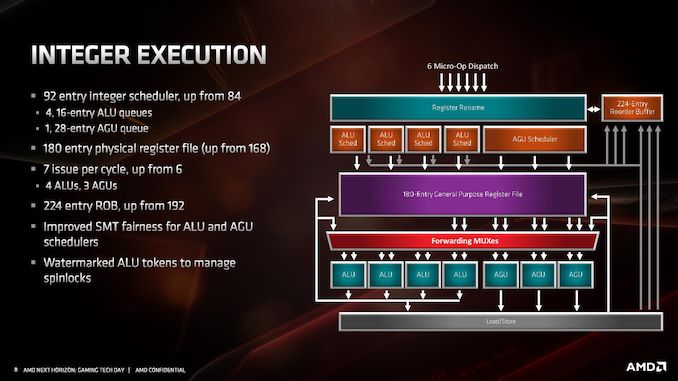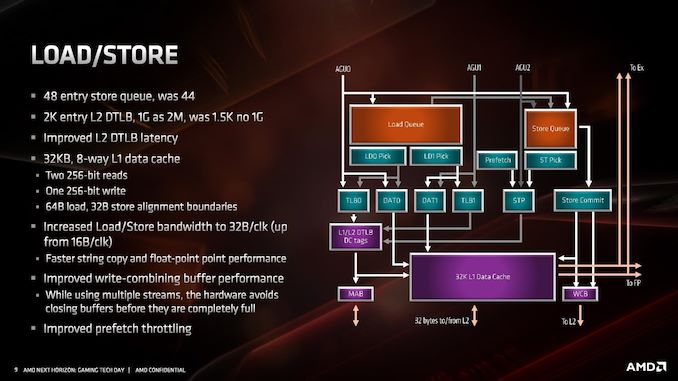AMD Zen 2 Microarchitecture Analysis: Ryzen 3000 and EPYC Rome
by Dr. Ian Cutress on June 10, 2019 7:22 PM EST- Posted in
- CPUs
- AMD
- Ryzen
- EPYC
- Infinity Fabric
- PCIe 4.0
- Zen 2
- Rome
- Ryzen 3000
- Ryzen 3rd Gen
Integer Units, Load and Store
The integer unit schedulers can accept up to six micro-ops per cycle, which feed into the 224-entry reorder buffer (up from 192). The Integer unit technically has seven execution ports, comprised of four ALUs (arithmetic logic units) and three AGUs (address generation units).
The schedulers comprise of four 16-entry ALU queues and one 28-entry AGU queue, although the AGU unit can feed 3 micro-ops per cycle into the register file. The AGU queue has increased in size based on AMD’s simulations of instruction distributions in common software. These queues feed into the 180-entry general purpose register file (up from 168), but also keep track of specific ALU operations to prevent potential halting operations.
The three AGUs feed into the load/store unit that can support two 256-bit reads and one 256-bit write per cycle. Not all the three AGUs are equal, judging by the diagram above: AGU2 can only manage stores, whereas AGU0 and AGU1 can do both loads and stores.
The store queue has increased from 44 to 48 entries, and the TLBs for the data cache have also increased. The key metric here though is the load/store bandwidth, as the core can now support 32 bytes per clock, up from 16.












216 Comments
View All Comments
The_Assimilator - Wednesday, June 12, 2019 - link
The original version of this article noted the 3950X price wasn't confirmed at the time of publication, but it seems they edited that bit out after Su's presentation.Still need the table to be updated - PCIe and DDR4 columns at least.
vFunct - Tuesday, June 11, 2019 - link
Eventually these Multi-chip packages should incorporate system DRAM (via HBM) as well as SSD NVRAM and GPUs, and sold as full packages that you'd typically see in common configurations. 64GB memory + 1TB SSD + 16 CPU cores + whatever GPU.mode_13h - Tuesday, June 11, 2019 - link
GPUs are often upgraded more often than CPUs. And GPUs dissipate up to about 300 W, while desktop CPUs often around 100 W (except for Intel's Coffee Lake).So, it wouldn't really seem like CPUs and GPUs belong together, either from an upgrade or a cooling perspective. Consoles can make it work by virtue of being custom form factor and obviously you don't upgrade a console's GPU or CPU - you just buy a new console.
Therefore, I don't see this grand unification happening for performance-oriented desktops. That said, APUs will probably continue to get more powerful and perhaps occupy ever more of the laptop market.
Threska - Tuesday, June 11, 2019 - link
I imagine that's why there's PCIe 4.0 and now 5.0.R3MF - Tuesday, June 11, 2019 - link
memory support?3200 official, or higher...
SquarePeg - Tuesday, June 11, 2019 - link
According to AMD 3200mhz is officially supported but they (AMD) have had memory clocked to over 5000mhz. Infinity fabric will run 1:1 with up to 3733mhz ram but any higher and it splits to 2:1. AMD also said that they have found DDR4 3600 16-21-21 to be the best bang for buck on performance returns.R3MF - Wednesday, June 12, 2019 - link
cheersGastec - Wednesday, June 12, 2019 - link
But will those be 3200 MHz overclocked (XMP) or 3200 SPD?Cooe - Wednesday, June 12, 2019 - link
The latter. Only >3200MHz is now overclocked.Lord of the Bored - Tuesday, June 11, 2019 - link
That security slide, though...Most of a page of "N/A"
I love it.